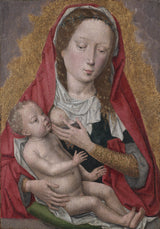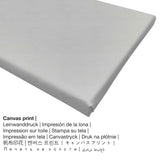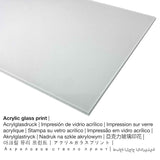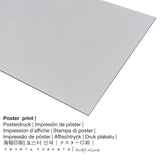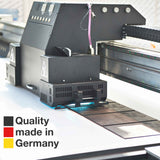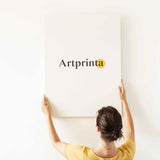ogbako Hans Memling, 1480 - Nwa agbọghọ na-amaghị nwoke na nwa - mbipụta nka mara mma
Ụtụ gụnyere. Mbupu gbakọrọ na ndenye ọpụpụ.
Ozi nkowa mgbakwunye site The Cleveland Museum of Art (© - Ụlọ ihe ngosi nka nke Cleveland - Velọ ihe ngosi nka nke Cleveland)
This small panel was once part of a devotional portrait diptych (a hinged two-panel painting). The Christ child’s attention seems drawn to something outside the picture and lifts his hand in recognition. The opposing panel, once hinged on the right, would have featured a portrait of its original owner in prayer, now unfortunately lost. Such devotional portrait diptychs were popular after 1400 and remained so until their production ceased around the 1530s. Used in private chapels or within the curtain folds of four-poster beds, they could easily be closed when not in use. Hans Memling was born near Frankfurt, Germany. He settled in Bruges around 1465 where he developed a reputation for his painting skills, and provided works to the Burgundian court, which likely cultivated the taste for small portrait diptychs. This example seems to have been painted by a member of Memling’s workshop, perhaps for a wealthy merchant or clergyman.
Ozi nka ahaziri
| Aha ọrụ nka: | "Vergin na Nwa" |
| Nhazi: | sere |
| Okwu mkpokọta: | nka ochie |
| oge: | 15th narị afọ |
| Afọ nka: | 1480 |
| Afọ nka: | 540 afọ |
| Agba na: | mmanụ n'elu osisi |
| Nha izizi (ọrụ nka): | Nhazi: 41,3 x 31,4 x 4,1 cm (16 1/4 x 12 3/8 x 1 5/8 na); Edebereghị: 31,5 x 22 cm (12 3/8 x 8 11/16 na) |
| Ụlọ ihe ngosi nka / mkpokọta: | Velọ ihe ngosi nka nke Cleveland |
| Ebe ngosi nka: | Cleveland, Ohio, United States nke America |
| website: | Velọ ihe ngosi nka nke Cleveland |
| Licensedị ikike: | ngalaba ọha |
| Site n'aka: | Velọ ihe ngosi nka nke Cleveland |
| Ebe E Si Nweta: | Ego Delia E. Holden na LE Holden |
Nchịkọta ihe nkiri
| Aha onye nka: | Ụlọ ọrụ Hans Memling |
| Ọrụ nke onye na-ese ihe: | onye na-ese ihe |
| Nhazi nke onye nka: | nna ukwu ochie |
Product ọmụma
| Nkewa edemede: | nka nka |
| Usoro mmeghari: | mmeputakwa n'ụdị dijitalụ |
| Usoro mmepụta: | UV kpọmkwem obibi |
| Mmalite nke ngwaahịa a: | arụpụtara na Germany |
| Ụdị ngwaahịa: | na mmepụta ihe |
| Eji ngwaahịa a chọrọ: | Ụlọ ihe osise nka, foto mgbidi |
| Ndozi onyonyo a: | nhazi ihe osise |
| Njikwa oyiyi: | 1: 1.4 |
| Ihe: | ogologo bụ 29% mkpụmkpụ karịa obosara |
| Akụrụngwa ị nwere ike ịhọrọ: | Mpempe akwụkwọ, akwụkwọ mmado (akwụkwọ akpa), mbipụta enyo acrylic (nwere ezigbo mkpuchi iko), mbipụta ọla (aluminium dibbond) |
| Nha n'arọwa n'elu ihe ndọtị (mbipụta akwa akwa): | 50x70cm - 20x28", 100x140cm - 39x55" |
| Mbipụta iko acrylic (nke nwere ezigbo mkpuchi iko): | 50x70cm - 20x28", 100x140cm - 39x55" |
| Mpempe akwụkwọ mmado (akwụkwọ kwaaji) nha dị iche iche: | 50x70cm - 20x28" |
| Ụdị mbipụta aluminom: | 50x70cm - 20x28", 100x140cm - 39x55" |
| Nhazi mbipụta nka: | agunyeghi |
Ngwa ngwaahịa a na-ahọpụta
The product dropdown menu gives you the chance to select the size and materialaccording to your preferences. Pick your preferred size and material among the following choices:
- Kwaaji: The printed canvas, which shall not be mistaken with a canvas painting, is a digital copy applied on a canvas. A canvas generates a distinctive look of three-dimensionality. A canvas print of your favorite artwork will allow you to transform your fine art print into a large artpiece like you would see in a true gallery. How do I hang a canvas on the wall? Canvas Prints have the advantage of being low in weight, which implies that it is easy to hang up the Canvas print without the use of any wall-mounts. A canvas print is suited for all kinds of walls.
- Aluminom dibond mbipụta (ọla): Aluminium Dibond prints are prints on metal with an impressive depth. A direct Aluminium Dibond Print is your perfect start to art replicas made on aluminum. For the Direct Aluminium Dibond option, we print the artpiece on the aluminium composite surface. The white & bright parts of the original artwork shimmer with a silky gloss, however without the glare. This print on Aluminum Dibond is the most popular entry-level product and is a truly sophisticated way to display fine art reproductions, as it puts 100% of the viewer’s focus on the whole artwork.
- Mbipụta akwụkwọ mmado (akwa akwa akwa): The Artprinta poster is a UV printed canvas paper with a slightly rough surface finish. It is excellently used for placing the fine art print in a custom frame. Please note, that depending on the size of the canvas poster print we add a white margin between 2-6 cm round about the print motif in order to facilitate the framing.
- Mbipụta iko acrylic na-egbuke egbuke (ya na mkpuchi iko n'ezie): A glossy acrylic glass print, often labelled as a plexiglass print, will transform the original artwork into brilliant décor and offers a viable alternative option to dibond and canvas art prints. The work of art will be custom-made with modern UV printing machines. This creates vibrant and deep print colors. The real glass coating protects your selected fine art print against light and heat for up to six decades.
Nkọwa ngwaahịa
The nka ochie onye na-ese ihe mere nka Ụlọ ọrụ Hans Memling in 1480. Ụdị nke eserese ahụ nwere nha ndị a: Nhazi: 41,3 x 31,4 x 4,1 cm (16 1/4 x 12 3/8 x 1 5/8 na); Edebereghị: 31,5 x 22 cm (12 3/8 x 8 11/16 na) ewe me ya ka ọ were ihe-ọcha mmanụ n'elu osisi. Nowadays, the artwork is in the the The Cleveland Museum of Art's digital collection, which is located in Cleveland, Ohio, United States nke America. Site n'ikike nke Velọ ihe ngosi nka nke Cleveland (ngalaba ọha). Ihe kredit nke artpiece bụ: Ego Delia E. Holden na LE Holden. Ọzọkwa, alignment bụ Eserese na nwere akụkụ akụkụ nke 1: 1.4, nke pụtara na ogologo bụ 29% mkpụmkpụ karịa obosara.
Ihe dị mkpa: We try whatever we can in order to depict the art products as exact as possible and to demonstrate them visually. Nevertheless, the colors of the print products and the imprint can differ somehwat from the presentation on your device's screen. Depending on the settings of your screen and the quality of the surface, colors can unfortunately not be printed one hundret percent realistically. Since the fine art prints are processed and printed by hand, there may also be slight discrepancies in the size and exact position of the motif.
© Nchekwa ikike nwebisiinka | Artprinta.com (Artprinta)

